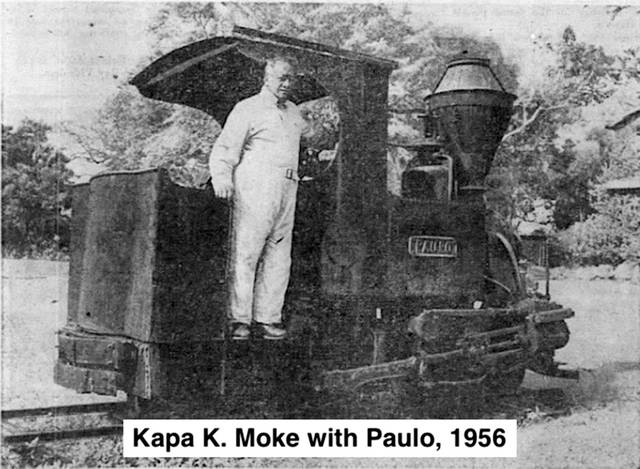Born in Koloa, Kauai, Kapa Keikeokalani Moke (1886-1965) was for many years a sugar train locomotive engineer, first for Koloa Sugar Co. and later for Grove Farm Co.
He began working for Koloa Sugar Co. as a mule driver in 1902 after quitting school at th e age of 16, and two years later, he was transferred to work as a brakeman on the locomotive Paulo, one of two locomotives then in operation at Koloa Sugar Co.
Two men operated Paulo. The engineer drove it and kept a careful eye on the glass indicator that showed the boiler pressure, while the brakeman handled the brakes and performed other duties.
Moke’s job was particularly important on trips to the mill from the Knudsen Gap side of the plantation, where nearly the entire distance was on a downgrade.
When the engineer signaled the approach to the grade with two blasts of the whistle, Kapa would jump off Paulo, run along side the cane cars, and turn the brakes on as many as 30 loaded cars and 60 to 70 empty ones at a time.
Then he’d run back to board the Paulo.
Another of Moke’s duties was to supply Paulo with water for its boilers.
Several times a day, Paulo would be driven to the nearest reservoir, where Moke would make a number of roundtrips with a water bucket from the reservoir to fill the boilers.
And, every morning the wood-burning Paulo would chug its way to the locomotive wood pile to take on logs that Moke would load into an empty cane car to fuel Paulo, which was in operation as late as 1920.
Coal-burning locomotives, introduced later on, likewise required a trip to the coal pile, where Moke would fill sacks with coal and load them into a cane car.
In 1909, after working for five years as brakeman, Moke was promoted to engineer and continued working as a locomotive engineer until he retired from Grove Farm in 1952.
Kapa Moke and his wife, Millie Hipa Moke, had a son, Daniel Kapa Moke.



Not bad. This was in 1900. Present day it’s another story. After going to school and borrowing a book on car stereo installation by Mark Rumreich, after 1 month and a half, my New career is a car technician. A job is made. LOL.
Case in point? Why does a speaker overheat when connected in parallel? 4-ohms each. The pair is both 2-ohms now. Prove that over use of speakers overheats. Math wise. Then comment.
Prove or verify: set V=IR, i= amps r=resistance V=volts. 12 volt battery. Impedance allows more power watts, therefore VI=watts increase and melts the speaker wires. More watts drawn. Current increases due to impedance. Free flow of currents.
He was Hawaiian and known for his HUGE hands and came to my parent’s house for a visit when I was a kid.